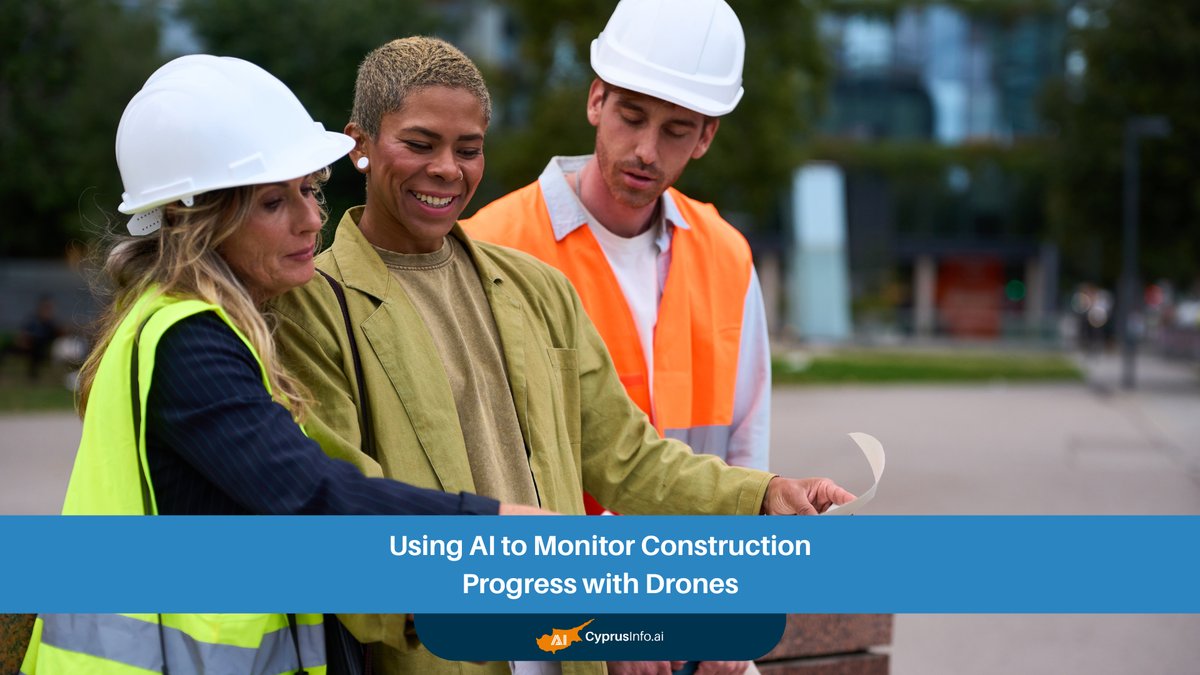The construction industry, a cornerstone of global infrastructure and economic development, is undergoing a profound transformation. Traditionally reliant on manual inspections, time-consuming surveys, and often reactive problem-solving, construction sites are now at the forefront of a technological revolution. At the heart of this shift lies the powerful synergy of Artificial Intelligence (AI) and drones, giving rise to sophisticated AI Construction Progress Monitoring solutions that promise unparalleled efficiency, accuracy, and safety.
Gone are the days when project managers had to painstakingly traverse vast construction sites, relying on clipboards and guesswork to assess progress. Today, drones equipped with high-resolution cameras and advanced sensors can autonomously collect gigabytes of data in minutes. But raw data alone is not enough; this is where AI steps in. AI algorithms process this massive influx of information, transforming it into actionable insights that drive smarter decisions, streamline workflows, and keep projects on schedule and within budget. This integration redefines automated construction progress tracking, offering a bird's-eye view with granular detail.
The Evolution of Construction Monitoring
For centuries, monitoring construction progress was a labor-intensive, often subjective task. Site managers would walk the perimeter, take photos, mark off checklists, and engage in numerous meetings to piece together an understanding of project status. This traditional approach, while foundational, was inherently prone to human error, delays, and an incomplete picture of complex, dynamic environments.
The advent of drones marked the first major leap. Initially used for simple aerial photography and videography, drones quickly proved their value in providing a comprehensive visual record of a site. They offered a new perspective, enabling better site planning, marketing, and a basic level of progress assessment. However, processing the sheer volume of drone-captured imagery and video manually remained a significant bottleneck. This limited the real-time applicability and scalability of drone-based construction inspection.
The true paradigm shift occurred with the integration of AI. By feeding drone data into AI-powered analytics platforms, the industry unlocked the potential for automated analysis, object recognition, anomaly detection, and predictive modeling. This fusion elevated drone capabilities from mere data collection to intelligent data interpretation, making AI Construction Progress Monitoring not just a possibility, but a necessity for competitive project execution.
How AI Construction Progress Monitoring Works with Drones
The operational framework of AI Construction Progress Monitoring is a sophisticated dance between aerial robotics and intelligent algorithms. It involves several critical stages, each leveraging cutting-edge technology to transform raw site data into strategic insights:
Data Acquisition: The Drone's Eye View
Automated Flights: Drones are programmed for autonomous flight paths, ensuring consistent data capture across the entire site. These flight plans can be easily replicated for daily or weekly monitoring.
Sensor Array: Equipped with high-resolution RGB cameras, LiDAR scanners, thermal cameras, and multispectral sensors, drones capture a diverse range of data from visual imagery to precise topographical information and heat signatures.
Data Processing: The AI Brain
Photogrammetry & 3D Modeling: AI-driven software stitches together thousands of drone images to create highly accurate 2D maps, 3D models, and point clouds of the construction site.
Computer Vision & Machine Learning: Advanced AI algorithms analyze these models. They can identify and classify objects (e.g., machinery, materials, personnel), track their movement, and compare the current state of the site against BIM (Building Information Modeling) plans or previous scans.
Analysis and Reporting: Actionable Insights
Progress Tracking: AI automatically quantifies completed work, identifying discrepancies between planned and actual progress. This includes volumetric measurements of earthworks, tracking material deliveries, and monitoring structural erection.
Anomaly Detection: The system highlights deviations from design plans, potential safety hazards, or quality control issues in real-time.
Predictive Analytics: Leveraging historical data and current progress, AI can forecast potential delays, resource shortages, or cost overruns, enabling proactive intervention.
Customizable Dashboards: Project managers receive clear, concise reports and interactive dashboards that visualize critical metrics and provide alerts, facilitating informed decision-making.
The AI & Drone Workflow
Automated Data Collection: Drones fly predefined routes, gathering consistent, high-fidelity data.
Intelligent Data Interpretation: AI algorithms convert raw data into meaningful metrics.
Real-time Comparison: Live site conditions are continuously compared against digital plans (BIM, CAD).
Proactive Problem Solving: Early identification of issues before they escalate.
Comprehensive Documentation: An indisputable, auditable record of the entire project lifecycle.
"The future of construction isn't just about building structures; it's about building smarter, faster, and safer. AI and drones are not just tools; they are the architects of that future, transforming how we oversee and manage complex projects." - Industry thought leader
Key Benefits of AI Construction Progress Monitoring
The adoption of AI Construction Progress Monitoring brings a multitude of advantages that directly impact project success metrics, from financial performance to operational safety.
Enhanced Accuracy and Detail
Traditional methods often suffer from limited vantage points and human error. Drones, combined with AI, capture incredibly precise data from every angle. This includes high-resolution imagery, accurate topographical maps, and detailed 3D models. AI then extracts quantifiable data, such as volume calculations for earthworks, precise measurements of installed components, and exact locations of equipment, leading to unparalleled real-time construction data analytics.
Significant Time and Cost Savings
By automating the laborious tasks of site inspection and data analysis, construction companies can drastically reduce the time spent on manual progress tracking. This translates into fewer personnel required for inspections, faster identification of issues, and less rework. The efficiency gains contribute directly to project profitability. For instance, automated construction progress tracking can cut down weekly survey times from days to hours, freeing up valuable human resources for more strategic tasks.
Improved Safety and Risk Management
Sending human inspectors into hazardous areas on a construction site poses significant risks. Drones can access difficult or dangerous locations, such as high elevations, unstable ground, or active work zones, without endangering personnel. AI then scrutinizes the collected data for safety compliance in construction with drones, identifying potential hazards, improper safety gear usage, or deviations from safety protocols. This proactive approach significantly reduces accidents and enhances overall site safety.
Better Decision-Making with Real-time Insights
Access to real-time, accurate data empowers project managers with the information needed to make swift and informed decisions. Instead of waiting for weekly reports, they can view progress updates daily, even hourly. This allows for immediate adjustments to schedules, resource allocation, and problem-solving, leveraging predictive analytics for construction schedules to anticipate future challenges.
Optimized Resource Allocation
AI can analyze the utilization of heavy machinery, material stockpiles, and workforce distribution. By understanding where resources are being over or under-utilized, project managers can optimize their deployment, ensuring that equipment and personnel are where they are needed most, when they are needed. This prevents bottlenecks and keeps the project flowing smoothly.
Core Technologies Powering AI Construction Progress Monitoring
The robust capabilities of AI Construction Progress Monitoring are built upon several interconnected advanced technologies:
Computer Vision: This branch of AI enables machines to "see" and interpret visual information. In construction, it allows AI to recognize objects (e.g., rebar, concrete pours, excavators), track their status, and compare them against digital plans. It's crucial for drone-based construction inspection.
Machine Learning (ML) & Deep Learning (DL): These algorithms are at the heart of AI's analytical power. They learn from vast datasets of construction images and 3D models to identify patterns, detect anomalies, and make predictions. ML models can classify different types of work, measure progress, and even forecast completion times.
Internet of Things (IoT) Integration: Drones are essentially flying IoT devices. When combined with other IoT sensors on site (e.g., smart hardhats, equipment trackers), they create a rich, interconnected data ecosystem. This allows for a more holistic view of the construction environment, contributing to comprehensive AI-powered site surveillance.
Digital Twins in Construction: A digital twin is a virtual replica of a physical asset, process, or system. Drones and AI continuously feed real-time data into a construction project's digital twin, keeping it updated. This twin serves as a dynamic, living model that reflects the current state of the site, enabling scenario planning, simulation, and highly accurate progress monitoring.
Cloud Computing: Processing the immense volume of data generated by drones and AI requires substantial computational power. Cloud platforms provide the scalable infrastructure needed to store, process, and analyze this data efficiently, making real-time insights accessible from anywhere.
Key Technologies for Smart Construction Monitoring
Technology | Primary Role in AI Construction Progress Monitoring | Benefit |
|---|---|---|
Drones (UAVs) | High-resolution data acquisition, aerial perspective | Comprehensive visual and spatial data, access to hazardous areas |
Computer Vision | Image and video analysis, object recognition, anomaly detection | Automated identification of progress, discrepancies, and hazards |
Machine Learning | Pattern recognition, predictive modeling, data interpretation | Forecasting, optimized decision-making, continuous improvement |
Digital Twins | Virtual replica for real-time comparison and simulation | Holistic project overview, 'what-if' scenarios, clash detection |
Cloud Computing | Scalable data storage, processing, and access | Collaboration, remote access, handling large datasets |
Practical Applications Across the Construction Lifecycle
The versatility of AI Construction Progress Monitoring extends across every phase of a project, from initial planning to handover and even facilities management.
Pre-Construction Phase
Before ground is even broken, drones can conduct detailed site surveys, topographical mapping, and environmental assessments with unparalleled speed and accuracy. AI processes this data to generate precise 3D models of the existing terrain, identify potential challenges, and inform optimal site layout and earthwork planning. This early stage application of UAVs for construction monitoring lays a strong foundation for the entire project.
During Construction Phase
This is where AI Construction Progress Monitoring truly shines:
Real-time Progress Tracking: Regular drone flights capture current site conditions, which AI compares against the BIM model and schedule. This provides immediate updates on work completed, materials used, and any deviations.
Quality Control: AI can detect structural misalignments, identify areas where concrete pours might be insufficient, or spot other quality deficiencies by comparing as-built conditions to design specifications. This revolutionizes how quality control is managed, moving from reactive to proactive.
Inventory Management: Drones can quickly scan material stockpiles, and AI can estimate volumes of aggregates, rebar, or other bulk materials. This helps in efficient inventory management and ensures timely reordering, preventing delays due to material shortages.
Equipment Tracking: AI-powered site surveillance tracks the movement and utilization of heavy machinery, providing insights into operational efficiency and helping to optimize equipment deployment.
Safety Monitoring: Beyond general site safety, AI can monitor for specific safety violations, such as workers not wearing helmets in designated areas or unsafe equipment operation, enhancing overall safety compliance.
Post-Construction & Facilities Management
Even after a project is completed, the data gathered through AI Construction Progress Monitoring remains invaluable. The final 3D models and digital twins serve as accurate as-built records for facilities management, maintenance planning, and future renovations. AI can analyze historical data to predict maintenance needs or identify areas of wear and tear, extending the lifecycle of the asset.
Challenges and Considerations in Implementing AI Construction Progress Monitoring
While the benefits are clear, adopting AI Construction Progress Monitoring is not without its hurdles. Understanding these challenges is crucial for successful implementation.
Data Security and Privacy
Construction sites often contain sensitive information, from proprietary designs to subcontractor details. The vast amounts of visual and spatial data collected by drones, and subsequently processed by AI, raise concerns about data security and privacy. Robust cybersecurity measures are essential to protect this information from breaches and unauthorized access. Companies must ensure compliance with data protection regulations, such as GDPR.
Regulatory Landscape
The use of UAVs for construction monitoring is subject to evolving aviation regulations. These can vary significantly by country and even by local jurisdiction, covering aspects like flight altitude, airspace restrictions, pilot licensing, and privacy concerns related to aerial surveillance. Navigating this complex regulatory environment requires careful planning and adherence to legal frameworks.
Integration with Existing Systems
Many construction firms operate with legacy software and fragmented data systems. Integrating new AI and drone platforms with existing BIM, ERP, and project management software can be complex. Seamless data flow is critical for maximizing the benefits of AI Construction Progress Monitoring, necessitating careful API development and data standardization.
Initial Investment and Skill Gap
The upfront cost of purchasing advanced drones, AI software licenses, and training personnel can be substantial. Furthermore, there's a growing demand for professionals skilled in drone operation, data science, and AI analytics in construction. Bridging this skill gap through training and recruitment is vital for effective deployment of these technologies. However, the long-term ROI often far outweighs these initial investments, especially when considering the significant efficiency gains and reduction in rework.
The Future of AI Construction Progress Monitoring
The current state of AI Construction Progress Monitoring is just the beginning. The horizon promises even more transformative advancements, driving construction technology innovation to unprecedented levels.
Autonomous Drone Fleets: Expect to see fleets of drones operating autonomously, coordinating their flights, and even performing minor corrective actions on-site without direct human intervention. This will lead to continuous, 24/7 monitoring capabilities.
Advanced Predictive Analytics: AI will move beyond just identifying current issues to predicting future problems with even greater accuracy. This includes forecasting equipment failures, material price fluctuations, and even geopolitical impacts on supply chains, further refining construction project management with AI.
Hyper-Realistic Digital Twins: Digital twins will become more sophisticated, incorporating real-time environmental data, material properties, and even simulating occupant behavior to optimize building performance long after construction. These will be continuously updated by Autodesk's insights on digital twins and AI insights.
Robotics Integration: Drones will increasingly work in tandem with ground-based robots for comprehensive site surveillance, material handling, and even automated construction tasks, creating a fully integrated smart construction ecosystem.
Edge AI: Processing AI algorithms directly on the drone (at the "edge") will enable faster, real-time decision-making without the need to send all data to the cloud, improving latency and data security.
"The convergence of AI, drones, and digital twins is not just incrementally improving construction; it's fundamentally redefining what's possible, pushing the boundaries of efficiency, sustainability, and safety for the built environment." - Dr. Sarah Jenkins, Construction Tech Innovator
CyprusInfo.ai: Your Partner in Next-Gen Construction Monitoring
Embracing the future of construction means integrating advanced technologies like AI Construction Progress Monitoring. At CyprusInfo.ai, we understand the complexities and opportunities within this evolving landscape. We are dedicated to empowering businesses with the insights and tools they need to thrive.
Our platform provides comprehensive resources, expert analysis, and connections to leading technology providers in the field of construction and real estate. Whether you're looking to understand the intricacies of AI in construction procurement, seeking solutions for AI construction defect detection, or exploring the benefits of AI-powered risk assessment for construction projects, CyprusInfo.ai is your go-to source.
We help you navigate the technological landscape, providing data-driven insights and connecting you with best-in-class solutions for implementing AI Construction Progress Monitoring. From understanding the regulatory frameworks for UAVs for construction monitoring to identifying the right software for real-time construction data analytics, our platform is designed to guide your digital transformation journey in construction.
Frequently Asked Questions About AI Construction Progress Monitoring
What types of drones are best suited for construction monitoring?
Drones equipped with high-resolution RGB cameras, LiDAR scanners for precise 3D mapping, and thermal cameras for detecting anomalies like moisture or heat loss are ideal. Enterprise-grade drones with advanced flight stability, longer flight times, and robust navigation systems are generally preferred for professional construction monitoring.
How does AI analyze drone data for construction progress?
AI uses computer vision algorithms to identify objects, measure dimensions, track changes over time, and compare current site conditions against BIM models or project schedules. It can automatically quantify progress, detect deviations, and highlight potential issues like material shortages or structural inaccuracies.
What are the primary benefits of using AI Construction Progress Monitoring?
The main benefits include enhanced accuracy in progress tracking, significant time and cost savings through automation, improved safety by reducing human exposure to hazards, better decision-making with real-time insights, and optimized resource allocation across the project lifecycle.
Is AI Construction Progress Monitoring suitable for all project sizes?
While often associated with large-scale projects, the technology is becoming increasingly scalable and affordable for small to medium-sized projects too. The benefits of improved efficiency and reduced errors can justify the investment for projects of various sizes, especially those with complex geometries or tight schedules.
What kind of regulatory hurdles exist for drone use in construction?
Regulations vary globally and locally, covering aspects like airspace restrictions, drone registration, pilot certification, maximum flight altitudes, and rules regarding flying over populated areas or near airports. It's crucial to consult local aviation authorities (e.g., FAA in the US, EASA in Europe) and obtain necessary permits.
How does AI-powered site surveillance improve construction safety?
AI can detect safety hazards such as workers not wearing appropriate PPE, unauthorized personnel in restricted zones, or unsafe equipment operation. It can also identify potential fall risks or unstable structures, issuing real-time alerts to prevent accidents and ensure safety compliance.
Can AI Construction Progress Monitoring integrate with Building Information Modeling (BIM)?
Absolutely. Integration with BIM is one of the most powerful applications. AI compares drone-captured 'as-built' data with the 'as-designed' BIM models, immediately highlighting discrepancies, clashes, and progress deviations. This creates a living digital twin of the project.
What data security concerns should be addressed when using this technology?
Data security is paramount. Companies must implement strong encryption for data in transit and at rest, establish strict access controls, use secure cloud storage, and ensure compliance with relevant data privacy laws. Choosing reputable vendors with proven security track records is also vital.
How does this technology assist with construction project management?
It provides project managers with unprecedented visibility into every aspect of the site. By automating progress reporting, identifying risks early, and offering predictive insights, it enables more effective resource planning, schedule adherence, and budget control, fundamentally transforming construction project management with AI.
What is the future outlook for AI Construction Progress Monitoring?
The future includes more autonomous drone operations, enhanced predictive capabilities for deeper insights into project risks and opportunities, seamless integration with ground robotics, and the development of hyper-realistic digital twins that offer comprehensive, real-time operational oversight for construction technology innovation.
Conclusion: Building Smarter, One Drone Flight at a Time
The confluence of AI and drones is not merely an incremental improvement; it represents a seismic shift in how the construction industry operates. AI Construction Progress Monitoring delivers an unparalleled level of precision, efficiency, and safety that traditional methods simply cannot match. From automating mundane tasks and identifying critical deviations in real-time to offering predictive insights that avert costly delays, this technology is empowering project managers to build smarter, faster, and with greater confidence.
Embracing this innovative approach means unlocking significant cost savings, ensuring superior quality, and fostering safer working environments. As the technology continues to evolve, we can expect even more sophisticated applications, pushing the boundaries of what's possible in the built environment. The future of construction is here, and it's being monitored from above, intelligently.
Unlock the Power of AI for Your Construction Projects Today!
Ready to revolutionize your construction progress monitoring and elevate your project efficiency?
Discover CyprusInfo.ai's Solutions


